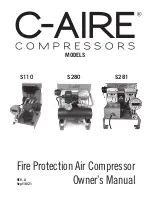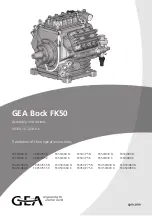
Section V– Servicing
Water Removal
Water vapor may condense in the separator reservoir and must be removed. The frequency with which
water must be removed is determined by the ambient air conditions. During hot and humid conditions,
water should be drained off the bottom of the reservoir daily. In cold and dry conditions, water may only
need to be drained weekly. To drain water from the reservoir, turn the compressor off and let set for at
least 5 minutes. Then open the drain valve. Water is heavier than the compressor fluid and will collect
at the bottom of the reservoir. When the drain is first opened some compressor fluid may come out
before the water starts to flow. Close the valve when the water flow changes to compressor fluid. Make
certain that there is no pressure in the reservoir before opening the drain valve.
Understanding the Analysis Report
a) REPORT DATE - The date that the fluid was analyzed.
b) REPORT NUMBER - The assigned number to this report.
c) CUSTOMER ADDRESS - The name and address of person that this report is being mailed to. This
information is being taken from the sample bottle as it is received.
d) CUSTOMER - The owner of the unit that sample came from.
e) COMPRESSOR MANUFACTURER - Brand of compressor sample taken from.
f) FLUID TYPE - This should always be QuinSyn IV or QuinSyn F fluids.
g) SERIAL NUMBER - The unit serial number of the Quincy compressor the fluid sample was taken from.
h) MODEL NUMBER - The model number of the Quincy compressor that the fluid sample was taken
from.
i) HOURS ON FLUID - These are the actual hours that the QuinSyn IV has been in the unit since the last
fluid change.
j) HOURS ON MACHINE - This is the total hours on the compressor hourmeter.
k) SAMPLE DATE - The date that the sample was taken from the compressor.
NOTE:
Items (c through k) are information provided by the service person supplying the fluid for analysis.
Incomplete or incorrect information will affect the report's accuracy.
l) EVALUATION - This is a brief statement made by the technician performing the actual fluid analysis.
This statement addresses the condition of the fluid and filter. This statement will also note any
problems that need attention.
m) PHYSICAL PROPERTIES RESULTS - Particle size is measured in microns.
n) SPECTROCHEMICAL ANALYSIS - See parameters page.
Fluid levels should fill the sight level gauge while the compressor is in operation.
DO NOT OVERFILL
.
Operating over full will result in high fluid carryover.
Quincy Compressor – QSF Series
25
Summary of Contents for QSF Series
Page 2: ......
Page 26: ...Section I V Operating Procedures Quincy Compressor QSF Series 22...
Page 30: ...Section V Servicing Quincy Compressor QSF Series 26...
Page 55: ......
















































